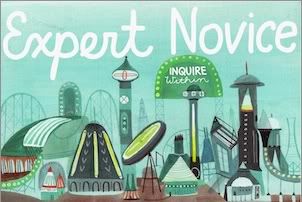But all of a sudden, I'm there all the time! Since MIT is like a technology wonderland, I think this is a sign that my hope of becoming awesome at the Internet by the end of 2007 is finding some success. At the very least, I'm moving closer to the source. Hang on, computers! Here I come!
So first, this week, it was a failed attempt to witness MITHenge on Monday. (Clouds obscure sunlight; who knew?)

What MITHenge in the Infinite Corridor would have looked like—if there had been any sunlight! Photo from this very geeky and wonderful site that explains MITHenge.
But the MITHenge-that-wasn't was just the beginning. Over the past two days, I've had the extremely energizing and overwhelming experience of attending Futures of Entertainment 2, put on by the Convergence Culture Consortium at MIT, otherwise known as C3. Having just attended Cyberposium at Harvard Business School last weekend, I noticed a few major differences between the two conferences. In the spirit of celebrating and investigating these two very weird and different spheres, I thought I'd talk about those differences for a minute.

First of all, Futures of Entertainment was quite a bit more forward-thinking than Cyberposium. Cyberposium had a much larger audience, but they were drastically less engaged than the audience at Futures of Entertainment. I heard someone make the observation that all the typing in the tiny FoE2 auditorium sounded like a cacophony of white noise. To me, it sounded like syncopated rain. It was so strange to sit in the audience and look out on the sea of laptop screens before me. It was especially weird to see people's "workflows" out of the corner of my eye. One of the speakers would mention a website, and immediately people were searching for it. Someone from the audience set up a group chatroom on Meebo to host a running, silent commentary. Most interesting part: the person who set up the chatroom advertised it on the group's "backchannel," a huge screen set up beside the speakers that displayed audience-generated comments and questions, and allowed other members of the audience to vote the comments up and down. Audience members looked at least as much to the board for information as to the speakers themselves.
The second difference was in the organization of the conference itself. FoE2 was a conference built for people who are Internet fluent, who live it and breathe it. I got the feeling at Cyberposium that the whole conference was just a nice little advertisement for future possibilities, geared toward a skeptical but curious audience. The conference was run, largely, in an extremely traditional way, and indeed, the results felt a bit stale at times. Although the panels were quick at Cyberposium—no more than an hour each—they cut off interesting conversations at the knees, because they weren't built for the kind of interaction that working in the Internet sphere demands. As a result, they felt much longer.
At FoE2, on the contrary, we had a conference built for Internet personalities. The panels were long—almost two and a half hours each!—but they absolutely flew by, due to the engagement of the speakers with each other and the audience with the speakers. The whole ecology of the conference was built around conventions of the Internet. There was even a tagging protocol put forward by the conference organizers, I think, that suggested all blog entries on the conference be tagged "MIT-FoE2" so that the conference organizers could "find and link to them." At first, this seemed curious to me. And then I realized that everyone was liveblogging the event. There's the official FoE2 liveblog on the C3 site, sure, but there were also many, many audience members whose own blog audiences are just as large.
I will admit, it was disconcerting for me to watch people's attention drifting in and out of the panels; it was disconcerting for their eyes, and mine, to so often be watching the "backchannel" screen to the left and up, instead of the facial expressions of the panel members themselves. Even though I've been known to rapidly shift tasks during lectures myself, I still felt bad for the speakers. Although I recognized this attention distribution to be completely natural for the situation, I still got the feeling that people were whispering behind the panelists' backs.
Accurate or not, this feeling does reveal one more aspect of the equation: it's not really "whispering" when the panelists, and everyone in the world, can read the whispers on your blog later. In a way, this whole interactive-and-reactive experience of the conference mirrored many of the problems and solutions posed by the conference. In a convergence culture, you will have a metalayer of commentary on whatever you're doing. No matter what. The question is: do you invite it or do you stifle it? Futures of Entertainment decided not only to invite it, but to welcome it with open arms and a couple pieces of freshly-baked baklava.
And although it may have been confronting to see audience members "not paying attention," or "not playing by the rules" with which we're all comfortable, I have to say that Futures of Entertainment managed to be simultaneously fascinating, energizing, and completely overwhelming.
Information overload converged on a point, and that point was two subway stops away. It worked. And you can bet I'll be back.



1 comment:
MIT... how I cringe at that place...
Post a Comment